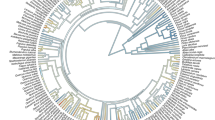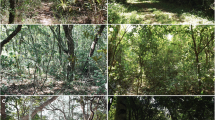Abstract
We previously hypothesised the existence of a “biogeochemical niche” occupied by each plant species. Different species should have a specific elemental composition, stoichiometry and allocation as a consequence of their particular metabolism, physiology and structure (morphology) linked to their optimal functioning under the environmental (abiotic and biotic) conditions where they have evolved. We tested this hypothesis using data from the Catalan Forestry Inventory that covers different forest groups growing under a large climatic gradient. Mediterranean species that occupy hotter–drier environments have lower leaf N, P and K concentrations than non-Mediterranean forest species. Within a determined climatic biome, different species competing in the same space have different elemental compositions and allocations linked to their taxonomical differences and their phenotypic plasticity. Gymnosperms have a proportionally higher elemental allocation to leaves than to wood, higher C concentrations, and lower N, P and K concentrations mainly in the stem and branches than angiosperms. The differences among species are linked to asymmetrical use of different elements, suggesting that the biogeochemical niche is a final expression and consequence of long-term species adaptation to particular abiotic factors, ecological role (stress tolerant, ruderal, competitor), different soil occupations and use of resources to avoid interspecific competition, and finally of a certain degree of flexibility to adapt to current environmental shifts.


Similar content being viewed by others
References
Aerts R (1999) Interspecific competition in natural plant communities: mechanism, trade-offs and plant-soil feedbacks. J Exp Bot 50:29–37
Babita M, Maheswari M, Rao LM, Shanker AK, Rao DG (2010) Osmotic adjustment, drought tolerance and yield in castor (Ricinus communis L.) hybrids. Environ Exp Bot 69:243–249
Baribault TW, Kobe RK, Finley AO (2012) Tropical tree growth is correlated with soil phosphorus, potassium, and calcium, though not for legumes. Ecol Monogr 82:189–203
Bréda N, Huc R, Granier A, Dreyer E (2006) Temperate forest trees and stands under severe drought: a review of ecophysiological responses, adaptation processes and long-term consequences. Ann For Sci 63:625–644
Elliot GN, Geoffrey N, Worgan H, Broadhurst D, Draper J, Scullion J (2007) Soil differentiation using fingerprinting Fourier transform infrared spectroscopy, chemometrics and genetic algorithm-based feature selection. Soil Biol Biochem 39:2888–2896
García LV (2004) Escaping the Bonferroni iron claw in ecological studies. Oikos 105:657–663
Gracia C, Burriel JA, Ibàñez JJ, Mata T, Vayreda J (2004) Inventari Ecològic i Forestal de Catalunya. Mètodes. Volum 9. CREAF, Bellaterra, p 112
Hailes KJ, Aitken RL, Menzies NW (1997) Magnesium in tropical and subtropical soils from north-eastern Australia. 1. Magnesium fractions and interrelationships with soil properties. Aust J Soil Res 35:615–627
Han WX, Fang JY, Reich PB, Woodward FI, Wang ZH (2011) Biogeography and variability of eleven mineral elements in plant leaves across gradients of climate, soil and plant functional type in China. Ecol Lett 14:788–796
Hernandez I, Alegre L, Munne-Bosch S (2004) Drought-induced changes in flavonoids and other low molecular weight antioxidants in Cistus clusii grown under Mediterranean field conditions. Tree Physiol 24:1303–1311
Howe GT, Aitken SN, Neale DB, Jermstad KD, Wheeler NC, Chen THH (2003) From genotype to phenotype: unravelling the complexities of cold adaptation in forest trees. Can J Bot 81:1247–1266
Johnson HE, Broadhurst D, Gooddacre R, Smith AR (2003) Metabolic fingerprinting of salt-stressed tomatoes. Phytochemistry 62:919–928
Kearney M (2006) Habitat, environment and niche: what are we modelling? Oikos 115:186–191
Kerkhoff AJ, Enquist BJ, Elser JJ, Fagan WF (2005) Plant allometry, stoichiometry and the temperature-dependence of primary productivity. Glob Ecol Biogeogr 14:585–598
Lapenis AG, Lawrence GB, Heim A, Zheng CY, Shortle W (2013) Climate warming shifts carbon allocation from stemwood to roots in calcium-depleted spruce forests. Glob Biogeochem Cycles 27:101–107. doi:10.1029/2011GB004268
Laus MN, Soccio M, Trono D, Liberatore MT, Pastore D (2011) Activation of the plant mitochondrial potassium channel by free fatty acids and acyl-CoA esters: a possible defense mechanism in the response to hyperosmotic stress. J Exp Bot 62:141–154
Lee BR, Muneer S, Jung WJ, Avice JC, Ourry A, Kim TH (2012) Mycorrhizal colonization alleviates drought-induced oxidative damage and lignification in the leaves of drought-stressed perennial ryegrass (Lolium perenne). Physiol Plant 145:440–449
Mediavilla S, Gallardo-Lopez V, González-Zurdo P, Escudero A (2012) Patterns of leaf morphology and leaf N content in relation to winter temperatures in three evergreen tree species. Int J Biometeorol 56:915–926
Naples BK, Fisk MC (2010) Belowground insights into nutrient limitation in northern hardwood forests. Biogeochemistry 97:109–121
Oddo E, Inzerillo S, La Bella F, Grisafi F, Salleo S, Nardini A, Goldstein G (2011) Short-term effects of potassium fertilization on hydraulic conductance of Laurus nobilis L. Tree Physiol 31:131–138
Ogaya R, Peñuelas J (2007) Leaf mass per ratio in Quercus ilex leaves under a wide range of climatic conditions. The importance of low temperatures. Acta Oecol 31:168–173
Peña-Rojas K, Aranda X, Joffre R, Fleck I (2005) Leaf morphology, photochemistry and water status changes in resprouting Quercus ilex during drought. Funct Plant Biol 32:117–130
Peñuelas J, Sardans J, Ogaya R, Estiarte M (2008) Nutrient stoichiometric relations and biogeochemical niche in coexisting plant species: effect of simulated climate change. Pol J Ecol 56:613–622
Peñuelas J, Sardans J, Llusia J, Owen S, Carnicer J, Giambeluca TW, Rezende EL, Waite M, Niinemets Ü (2010) Faster returns on ‘leaf economics’ and different biogeochemical niche in invasive plant species. Glob Change Biol 16:2171–2185
Peterson ML, Rice KJ, Sexton JP (2013) Niche partitioning between close relatives suggests trade-offs between adaptation to local environments and competition. Ecol Evol 3:512–522
Petrov KA, Sofronova VE, Bubyakina VV, Perk AA, Tatarinova TD, Ponomarev AG, Chelapov VA, Okhlopkova ZM, Vasilieva IV, Maximov TC (2011) Woody plants of Yakutia and low-temperature stress. Russ J Plant Physiol 58:1011–1019
Pons X (2009) MiraMon. Geographic Information System and Remote Sensing Software. Centre de Recerca Ecològica i Aplicacions Forestals, CREAF. Barcelona, Spain. ISBN: 84-931323-5-7
Qadir A, Malik RN, Husain SZ (2008) Spatio-temporal variations in water quality of Nullah Aik-tributary of the river Chenab, Pakistan. Environ Monit Assess 140:43–59
Raamsdonk LM, Teusink B, Broadhurst D, Zhang NS, Hayes A, Walsh MC, Berden JA, Brudle KM, Kell DK, Rowland JJ, Westerhoff HV, van Dam K, Oliver SG (2001) A functional genomics strategy that uses metabolome data to reveal the phenotype of silent mutations. Nat Biotechnol 19:45–50
Reich PB, Oleksyn J (2004) Global patterns of plant leaf N and P in relation to temperature and latitude. Proc Natl Acad Sci USA 101:11001–11106
Rivas-Ubach A, Sardans J, Pérez-Trujillo M, Estiarte M, Peñuelas J (2012) Strong relationship between elemental stoichiometry and metabolome in plants. Proc Natl Acad Sci USA 109:4181–4186
Sakai A (1983) Comparative study on freezing resistance of conifers with special reference to cold adaptation and its evolutive aspects. Can J Bot 61:2323–2332
Santiago LS, Wright SJ, Harms KE, Yavitt JB, Korine C, Garcia MN, Turner BL (2012) Tropical tree seedling growth responses to nitrogen, phosphorus and potassium addition. J Ecol 100:309–315
Sardans J, Peñuelas J (2007) Drought changes phosphorus and potassium accumulation patterns in an evergreen Mediterranean forest. Funct Ecol 21:191–201
Sardans J, Peñuelas J (2013) Tree growth changes with climate and forest type are associated with relative allocation of nutrients, especially phosphorus, to leaves and wood. Glob Ecol Biogeogr 22:494–507
Sardans J, Peñuelas J, Estiarte M, Prieto P (2008) Warming and drought alter C and N concentration, allocation and accumulation in a Mediterranean shrubland. Glob Change Biol 14:2304–2316
Sardans J, Rivas-Ubach A, Peñuelas J (2011a) Factors affecting nutrient concentration and stoichiometry of forest trees in Catalonia (NE Spain). For Ecol Manage 262:2024–2034
Sardans J, Peñuelas J, Rivas-Ubach A (2011b) Ecological metabolomics: overview of current developments and future challenges. Chemoecology 21:191–225
Sardans J, Rivas-Ubach A, Peñuelas J (2012a) The elemental stoichiometry of aquatic and terrestrial ecosystems and its relationships with organismic lifestyle and ecosystem structure and function: a review and perspectives. Biogeochemistry 111:1–39
Sardans J, Peñuelas J, Coll M, Vayreda J, Rivas-Ubach A (2012b) Stoichiometry of potassium is largely determined by water availability and growth in Catalonian forests. Funct Ecol 26:1077–1089
Sardans J, Rivas-Ubach A, Peñuelas J (2012c) The C:N:P stoichiometry of organisms and ecosystems in a changing world: a review and perspectives. Perspect Plant Ecol Evol Syst 14:33–47
Sistla SA, Schimel JP (2012) Stoichiometric flexibility as a regulator of carbon and nutrient cycling in terrestrial ecosystems under change. New Phytol 196:68–78
Stamova BS, Roessner U, Suren S, Laudencia-Chigcuano D, Bacic A, Beckles DM (2009) Metabolic profiling of transgenic wheat over-expressing the high-molecular-weight Dx5 glutenin subunit. Metabolomics 5:239–252
Sterner RW, Elser JJ (2002) Ecological stoichiometry: the biology of elements from molecules to the biosphere. Princeton University Press, Princeton, NJ
Tripler CE, Kaushal SS, Likens GE, Walter MT (2006) Patterns in potassium dynamics in forest ecosystems. Ecol Let 9:451–466
Vilà M, Vayreda J, Gracia C, Ibàñez JJ (2003) Does tree diversity increase wood production in pine forests? Oecologia 135:299–303
Villaescusa R, Díaz R (1998) Segundo Inventario Forestal Nacional (1986–1996). Ministerio de Medio Ambiente, ICONA, Madrid
Villanueva JA (2005) Tercer Inventario Forestal Nacional (1997–2007). Ministerio de Medio Ambiente, Madrid
Vitousek PM, Porder S, Houlton BZ, Chadwick OA (2010) Terrestrial phosphorus limitation: mechanisms, implications, and nitrogen–phosphorus interactions. Ecol Appl 20:5–15
Wright SJ, Yavitt JB, Wurzburger N, Turner BL, Tanner EVJ, Sayer EJ, Santiago LS, Kaspari M, Hedin LO, Harms KE, Garcia MN, Corre MD (2011) Potassium, phosphorus, or nitrogen limit root allocation, tree growth, or litter production in a lowland tropical forest. Ecology 92:1616–1625
Yuan Z, Chen HYH (2009) Global trends in senesced-leaf nitrogen and phosphorus. Glob Ecol Biogeogr 18:532–542
Zheng S, Shangguan Z (2007) Spatial patterns of leaf nutrient traits of the plants in the Loess Plateau of China. Trees Struct Funct 21:357–370
Acknowledgments
This research was supported by Spanish Government projects CGL2010-17172 and Consolider-Ingenio Montes CSD2008-00040, by Catalan Government project SGR 2009-458 and by the European Research Council Synergy Grant ERC-2013-SyG 610028-IMBALANCE-P.
Author information
Authors and Affiliations
Corresponding author
Additional information
Communicated by Peter Minchin.
Electronic supplementary material
Below is the link to the electronic supplementary material.
Rights and permissions
About this article
Cite this article
Sardans, J., Peñuelas, J. Climate and taxonomy underlie different elemental concentrations and stoichiometries of forest species: the optimum “biogeochemical niche”. Plant Ecol 215, 441–455 (2014). https://doi.org/10.1007/s11258-014-0314-2
Received:
Accepted:
Published:
Issue Date:
DOI: https://doi.org/10.1007/s11258-014-0314-2




